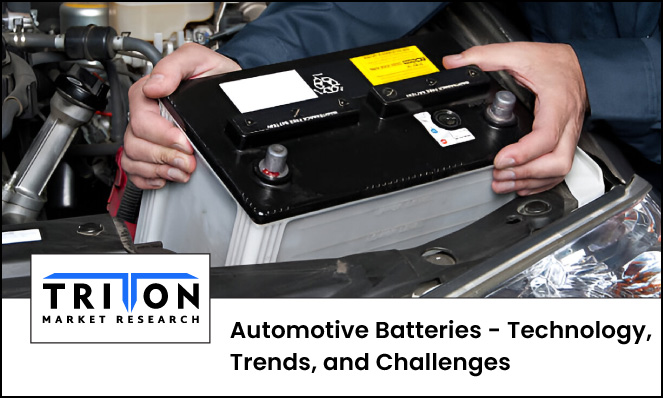



30, January 2025

The evolution of automotive batteries is marked by significant technological advancements that continue to shape the power in vehicles. From traditional lead-acid batteries to lithium-ion solutions and other innovations, the automotive battery sector is progressing toward a more sustainable future in the transport industry.
This blog delves into the technology behind the essential battery components, current trends, and challenges faced by the industry, offering a glimpse into what lies ahead.
Automotive batteries are the core component of modern vehicles, providing the energy required to start engines, power accessories, and drive electric vehicles (EVs). What are the main types of automotive batteries? Automotive batteries are primarily categorized into lead-acid and lithium-ion types, with emerging technologies such as solid-state gaining traction.
Lead-acid batteries, a long-standing choice, are cost-effective and reliable, making them ideal for traditional internal combustion engine (ICE) vehicles. However, their relatively low energy density and limited lifespan pose challenges.
On the other hand, lithium-ion batteries, known for their high energy density and performance, have become the standard for EVs due to their ability to store more energy in a lighter package. Emerging technologies, such as solid-state and flow batteries, promise even greater efficiency and safety, signaling a transformative shift in battery design.
In the context of battery charge and discharge cycles, batteries rely on chemical reactions to store and release energy. The capacity and output of a battery depend on factors such as its chemistry, size, and operating conditions. External influences, including temperature, charging habits, and usage patterns, also play a crucial role in determining a battery’s performance and lifespan.
To optimize battery functionality and longevity, Battery Management Systems (BMS) have become indispensable. These systems monitor and regulate various aspects of battery operation, ensuring safety, efficiency, and performance. Advanced BMS features, such as thermal management and state-of-charge estimation, help prevent overheating and overcharging while extending the overall lifespan of the battery. Thus, BMS plays a pivotal role in maintaining the health of EV batteries and ensuring seamless integration with the vehicle’s powertrain.
The automotive industry is undergoing a profound transformation driven by the growing adoption of electric vehicles. For instance, the global demand for automotive lithium-ion batteries surged by 65% in 2022, reaching approximately 550 GWh, according to the International Energy Agency. This significant increase was driven by the expansion of electric passenger car sales, with new EV registrations rising by 55% year-over-year in 2022.
An important aspect of automotive batteries is the duration. But how long do automotive batteries typically last? The lifespan of an automotive battery varies based on type and usage, with lead-acid batteries lasting 3–5 years and lithium-ion batteries offering 8–10 years or more.
Hence, researchers are exploring solutions to address more challenges of EV adoption, such as reducing charging times and increasing energy density. Faster-charging batteries, capable of replenishing energy in minutes rather than hours, are already being developed.
Simultaneously, improvements in energy efficiency and density are enabling EVs to travel greater distances on a single charge, addressing a key concern for consumers. Sustainability is another critical focus, with innovations in battery recycling and material reuse helping to minimize environmental impact.
Active Efforts by Market ContendersIndustry players, including established manufacturers and ambitious startups, are shaping the future of automotive batteries through continuous innovation. Companies such as Tesla, CATL, and Panasonic are leading the charge in developing high-performance batteries for EVs. Collaboration between the automotive and technology sectors has also led to groundbreaking advancements in automotive batteries.
For instance, on January 10, 2025, SAIC and CATL announced an expanded partnership to develop EV batteries that are swappable and collaborate in global markets. SAIC will produce EVs using CATL’s swappable batteries, while CATL will provide battery leasing and swapping services, introducing a model that separates battery ownership from vehicle sales.
Similarly, Sila Nanotechnologies, a US-based company, is transforming the electric vehicle (EV) sector with advanced battery materials designed to improve performance and sustainability. Their silicon anode technology enhances the energy density of lithium-ion batteries by up to 20%, enabling a 15–20% increase in the driving range or the development of smaller, lighter battery designs.
Despite the remarkable progress, several challenges remain in the development and deployment of automotive batteries.
Cost is a significant barrier, with raw material prices, particularly for lithium, cobalt, and nickel, fluctuating due to supply chain constraints and growing demand. Economies of scale in production are crucial to making EV batteries more affordable for consumers, but achieving this requires substantial investments in manufacturing infrastructure.
Environmental and safety concerns also demand attention. The disposal and recycling of used batteries pose ecological challenges, as improper handling can lead to hazardous waste. Fires and battery malfunctions, though rare, highlight the importance of rigorous safety measures in battery design and manufacturing. Additionally, the extraction of raw materials used in batteries has a significant environmental impact, underscoring the need for more sustainable practices.
Infrastructure limitations further complicate the widespread adoption of EVs. While charging networks are expanding rapidly, many regions still lack the necessary coverage to support EV users. Compatibility issues between charging stations and vehicle models add another layer of complexity. Moreover, the increased energy demand on electrical grids raises questions about the ability of current infrastructure to support large-scale electrification.
The future of automotive batteries is driven by innovation and the growing need for sustainability. Advances in chemical composition in a battery are expected to deliver higher energy densities, faster charging, and longer lifespans. Researchers are exploring renewable energy sources for battery production, reducing the environmental footprint of manufacturing processes. Innovations in lifecycle management, such as second-life applications and efficient recycling methods, promise to enhance the sustainability of batteries.
Integration with smart technology is another promising avenue. Vehicle-to-grid (V2G) technology represents a significant step towards a more interconnected and sustainable energy system. Enhanced user interfaces and connectivity features are also expected to improve the overall experience for EV owners, making battery management more intuitive and user-friendly.
Policy and market forces will play a critical role in shaping the trajectory of automotive batteries. Governments and organizations worldwide are implementing legislation to promote the adoption of clean energy vehicles.
Consumer behavior will also be instrumental, as growing awareness of environmental issues and the demand for sustainable alternatives drive innovation and adoption. As the world transitions towards a cleaner and more sustainable future, automotive batteries will remain at the forefront of this transformation.
Answer- Research into recycling methods is improving efficiency, enabling the recovery of valuable materials such as lithium and cobalt for reuse.
Q.2 How do different battery types affect vehicle performance?Answer- Lithium-ion batteries offer superior energy density and performance, making them ideal for EVs, while lead-acid batteries remain cost-effective for traditional vehicles.

Prevalent cases of terrorist attacks in today’s world is increasing the need for severe standards of security for public safety, and the global market for biometric technology scrupulously accommoda..
Prevalent cases of terrorist attacks in today’s world is increasing the need for..